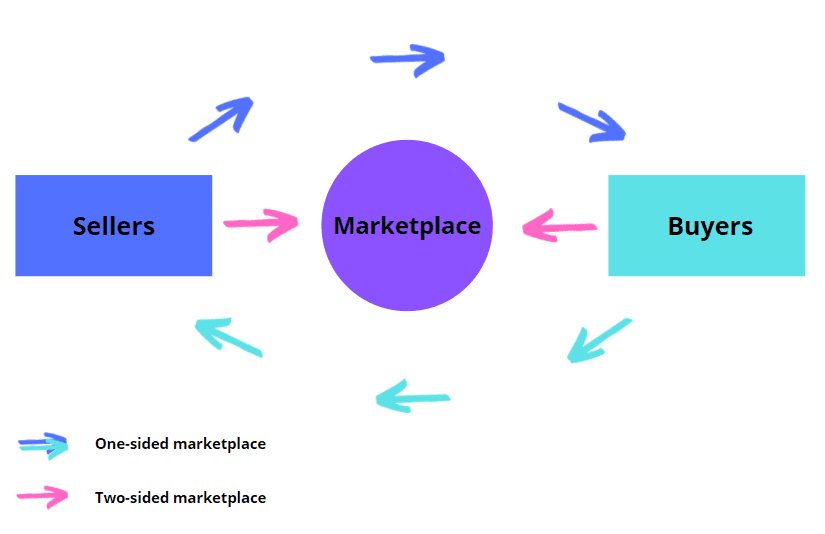
What is a Two-Sided Marketplace?
In the dynamic realm of two-sided markets, often referred to as multi-sided platforms (MSPs) or two-sided networks, digital ecosystems have redefined how buyers and sellers interact. Platforms like Airbnb, Fiverr, eBay, and Uber exemplify this transformative business model, creating a symphony of value within the two-sided market.
Terminology may vary, with references to two-sided market systems—all encapsulating the same concept. The success of the two-sided business model has been nothing short of remarkable, with projections indicating a global income doubling from under $20 billion in 2014 to over $40 billion by 2022, according to a Coresight Research report.
The Growth Potential: A Closer Look
PwC takes the optimism further, estimating that the revenues in the sharing economy, fueled by the two-sided marketplace model, could skyrocket to a staggering $335 billion by 2025. What sets two-sided markets apart, driving such confidence in their growth potential?
1. Scalability: Building Giants Without Owning the Kingdom
Scalability is a linchpin for two-sided marketplaces. Unlike traditional businesses, they can achieve global prominence without owning the assets they facilitate transactions for. Take Airbnb, for instance—it stands among the top 100 companies in the travel industry without owning a single hotel room. The allure is clear—you can build a global business without the burden of initial inventory investment. Numerous successful marketplaces stand as testament, having been built from the ground up through bootstrapping.
2. Marketplace Software: Breaking Barriers to Entry
The evolution of marketplace technology, crucial for the two-sided marketplace platform, has played a pivotal role. In the early days, creating a platform with intricate two-sided functionality and transaction flows took months and significant financial resources. Today, thanks to advancements and the rise of Software as a Service (SaaS) solutions, building a multi-sided platform is more accessible than ever. Platforms like CS-Cart, Sharetribe, and others empower entrepreneurs to bring their two-sided market ideas to life, irrespective of industry or business size. The time and budget required for launch have significantly decreased, leveling the playing field for aspiring marketplace creators.
3. Two-Sided Dynamics: Catalyzing Growth Through Connectivity
The unique dynamics of two-sided markets, driven by the network effect, contribute to their accelerated growth. Phenomena like the network effect come into play, creating a positive feedback loop that benefits all stakeholders—buyers, sellers, and the two-sided marketplace itself. This interconnectedness fuels the expansion of the two-sided business model, propelling it beyond the sum of its parts.
4. Community Building: The Heartbeat of Two-Sided Marketplace Growth
Beyond scalability, accessible two-sided marketplace software, and two-sided dynamics, community building emerges as a pivotal growth factor for two-sided marketplaces.
Fostering Trust for Repeat Business in the Two-Sided Network
Successful two-sided markets prioritize trust. Platforms like Etsy, for instance, thrive on the trust forged between artisans and buyers, creating a community where trust is the currency driving repeat transactions and word-of-mouth referrals.
Loyalty Powers Two-Sided Marketplace Growth
Loyalty is a formidable force in the two-sided market equation. A sense of belonging and loyalty encourages users to return, amplifying the success of the two-sided marketplace. This loyalty extends not just to buyers but also to sellers who find value in a platform that prioritizes their prosperity.
Long-Term Success Through Community in the Two-Sided Network
Sustainable growth is the goal for two-sided markets. By building a community around shared values, transparency, and commitment to user well-being, a two-sided marketplace ensures its longevity. This virtuous cycle of trust, loyalty, and sustainable growth transforms the platform into a thriving digital community.
In the following sections, we'll delve into strategies for effective community building, unlocking the full potential of this fourth dimension in the growth trajectory of two-sided marketplaces.
What is the Difference Between a One-Sided and a Two-Sided Marketplace?
In the realm of online commerce, the structure of a marketplace significantly impacts its dynamics and success, especially when considering two-sided marketplaces. Understanding the difference between one-sided and two-sided markets is crucial for entrepreneurs and business strategists shaping their businesses.
User Interaction
One-Sided Marketplace: Involves a single type of user, such as an e-commerce platform connecting sellers with buyers in a linear relationship.
Two-Sided Marketplace: Introduces a dynamic where two distinct user groups interact—this unique characteristic is at the core of two-sided markets. Purchasers and sellers engage with each other, creating a network effect that enhances user experience and amplifies growth potential.
Value Exchange
One-Sided Marketplace: The value exchange is straightforward, moving unidirectionally from sellers to buyers. This traditional model represents the foundational concept of platform business models.
Two-Sided Marketplace: The value exchange is multidimensional, encompassing offerings for buyers and a growing customer base for sellers. This reciprocal exchange defines the essence of two-sided models.
Network Effects
One-Sided Marketplace: Network effects are limited to the buyer-seller relationship, a standard feature in traditional business models.
Two-Sided Marketplace: Thrives on network effects that span both groups. As more buyers join, it attracts more sellers, creating a positive feedback loop for accelerated growth—this is the essence of two-sided networks.
Business Model Complexity
One-Sided Marketplace: The business model is relatively straightforward, with revenue generated through fees, commissions, or other monetization methods. Traditional business models often fit this description.
Two-Sided Marketplace: Introduces added complexity. Balancing the needs and incentives of both customers and sellers requires strategic considerations, emblematic of modern platform business models.
Chicken and Egg Problem
Two-Sided Marketplace: The chicken and egg problem is inherent in two-sided markets. At the initial stages, attracting both buyers and sellers can be challenging. However, once the critical mass is achieved, the network effect takes over, enabling direct interactions and fueling exponential growth.
Understanding these distinctions is pivotal for informed decision-making when entering the online marketplace space. The integration of two-sided business models, network effects, and solutions to the chicken and egg problem represents a strategic approach in building successful platform ecosystems. In the subsequent sections, we'll explore the benefits and challenges inherent in both one-sided and two-sided marketplace models.

What are Two-Sided Marketplace Examples?
In the realm of two-sided marketplaces, platforms like eBay, Uber, Fiverr, and Airbnb have reshaped how buyers and sellers interact, leveraging the power of network effects and successful two-sided marketplace models.
eBay. eBay pioneered online marketplaces, connecting individual and professional sellers directly with consumers. Its versatility accommodates various transaction formats, making it a dynamic space for exchanges. The network effects on eBay are evident as more users join, amplifying the platform's reach and creating a robust two-sided network.
Uber. Uber transformed transportation by seamlessly connecting riders with drivers, showcasing the success of a two-sided marketplace concept. Its real-time matching optimizes supply and demand, providing an efficient and accessible experience for both drivers and riders. The platform's growth is fueled by network effects, attracting more users and expanding the reach of its two-sided system.
Fiverr.Fiverr operates as a freelance marketplace, bridging businesses and individuals with skilled freelancers. The platform's key feature lies in matching specific skills with project needs, creating a mutually beneficial environment. As users engage with Fiverr, the network effects enhance the value exchange, solidifying its position as a successful two-sided marketplace.
Airbnb. Airbnb disrupted hospitality by connecting travelers with hosts offering unique accommodations. Its key feature is the facilitation of interactions between hosts and guests, fostering a sense of community and personalized experiences. Airbnb's success is intricately linked to its two-sided marketplace concept, where distinct user groups come together, creating a network effect that attracts other users seeking unique and authentic stays.

In these examples, the successful two-sided marketplace model is evident, with user groups directly engaging in transactions that go beyond a simple exchange of goods and services. The network effects play a pivotal role in the growth of these platforms, creating a positive feedback loop as more users join, enriching the overall experience for all participants in the multi-sided platform. As the digital landscape evolves, these two-sided networks continue to thrive, exemplifying the enduring power of two-sided marketplace ecosystems.
Benefits of Creating a Two-Sided Marketplace
In the intricate ecosystem of two-sided marketplaces, where administrators and sellers play pivotal roles, a multitude of benefits emerges, catering to the interests of both managing parties.
Advantages for Owners/Administrators:
1. Efficient Management:
- No need to deal with contractors: The two-sided marketplace model streamlines management, allowing administrators to focus on maintaining the platform's infrastructure. This efficient business model reduces the burden of dealing with individual sellers, creating a more scalable and adaptable platform.
2. Enhanced Customer Base:
- Greater buyer reach: Compared to a traditional business model, a two-sided marketplace inherently attracts a more extensive pool of buyers. The diverse range of sellers and products enhances the platform's visibility, creating ample opportunities for cross- and up-marketing—a key element in the value propositions of successful platforms.
3. Marketing Opportunities:
- Expanding product range: The variety of goods offered by different sellers opens avenues for effective cross-marketing, a strategy often employed by successful two-sided platforms. Administrators can strategically promote complementary products or encourage buyers to explore diverse offerings, enhancing the overall shopping experience and reinforcing the network benefits.
4. Client Interaction:
- Building customer relationships: Modern two-sided markets transcend mere transactional platforms. They serve as interactive spaces where administrators can engage with clients through reviews, comparisons, and an extensive product assortment—a direct network effect. This direct interaction fosters a sense of community and customer loyalty, a crucial element in the success of two-sided networks.
5. Ease of Promotion:
- Attractive promotional features: Marketplaces inherently attract customers through user-generated reviews, easy product comparisons, and a wide assortment, leveraging direct network effects. Leveraging these features, administrators can effectively promote the platform without relying solely on traditional advertising methods. The value proposition of the platform becomes more apparent as network effects attract more users.
Advantages for Sellers:
1. Expanded Reach:
- Additional traffic channel: Sellers benefit from an additional channel that funnels potential customers directly to their offerings, capitalizing on direct network effects. This expanded reach increases the visibility of their products, attracting a diverse customer base—a hallmark of successful two-sided networks.
2. Geographical Expansion:
- Sales beyond borders: Marketplaces facilitate the geographical expansion of sales. Sellers can tap into new markets without the need for extensive marketing efforts, leveraging the existing infrastructure of the platform—a distinct advantage of two-sided marketplace platforms.
3. Cost Optimization:
- Advertising efficiency: Sellers can optimize advertising costs by leveraging the marketplace's existing promotional features—a testament to the efficiency of two-sided platforms. The inherent visibility and customer engagement on the platform reduce the need for extensive external advertising, showcasing the cost optimization inherent in the two-sided marketplace business model.
4. Quick Store Launch:
- Rapid entry to the market: Launching a store on a marketplace is a swift process, a feature that aligns with the quick scalability of two-sided networks. Sellers can establish their presence and start reaching customers without the time and resources required for standalone store promotion.
5. Reduced Marketing Efforts:
- Store promotion not required: Sellers benefit from the marketplace's brand and user base, minimizing the need for extensive individual store promotion efforts. The platform itself becomes a marketing channel, saving both time and resources. This reduction in marketing efforts is a key advantage of two-sided marketplaces.
Creating a two-sided marketplace not only streamlines the management process for administrators but also provides a dynamic and lucrative environment for sellers to thrive. The synergistic relationship between these two managing parties contributes to the sustained success of a well-structured and efficiently managed two-sided marketplace.
Launching a Successful Two-Sided Marketplace: Key Considerations
Navigating the dynamic landscape of two-sided markets involves a multifaceted approach, considering various factors critical for success. Drawing insights from industry experts and accomplished marketplace entrepreneurs, we delve into key considerations for launching your two-sided venture.
1. Mitigate Marketplace Platform Leakage:
In the ever-evolving landscape of two-sided markets, controlling transactions is paramount. The allure lies in offering a frictionless experience, but vigilance is essential to avoid marketplace platform leakage, where transactions migrate outside due to payment issues or high commissions. Upholding an exceptional user experience is crucial, ensuring that your platform remains the preferred choice for both buyers and sellers.
2. Prioritize Seamless Integration and Scalability:
Adaptability is the cornerstone in the realm of two-sided markets. As your platform gains traction, prioritizing seamless integration of features, technologies, and user experiences becomes imperative. A flexible infrastructure ensures that your marketplace can evolve alongside shifting market demands and emerging industry trends. Scalability, integral to sustained success, positions your platform for long-term viability in the competitive landscape, accommodating a growing user base without compromising performance.
3. Tackle the Chicken-or-Egg Dilemma Strategically:
The inherent challenge of attracting buyers and sellers simultaneously, known as the chicken-or-egg problem, demands strategic solutions. Prioritize the more elusive user group initially to pave the way for the easier side to flow in naturally. Successful platforms often concentrate on attracting service businesses, recognizing that once a robust selection of affiliated customers is available, more buyers will follow suit, creating a thriving two-way market.
4. Cultivate Trust Across the Board:
Trust forms the bedrock of any flourishing two-sided marketplace. Rigorous vetting of both buyers and sellers, especially in the early stages, distinguishes your platform. While established giants may adopt a more open approach, startups benefit from pre-screening early adopters, ensuring a high-quality user base. This commitment to trust sets the stage for a reputable environment, fostering direct interactions between the two user groups.
5. Embrace the Power of Volume:
Volume, the lifeblood of two-sided markets, is integral to creating a virtuous cycle. Vaibhav Kakkar, CEO of Digital Web Solutions, highlights the network effect, where users amplify the platform's value. In a two-sided marketplace, cross-side virality comes into play—more buyers attracting new suppliers, initiating perpetual expansion. Achieving substantial volume on both sides, the buyers and sellers, is key to unlocking the full potential of your platform.
6. Educate and Monitor Proactively:
Education is a linchpin for success in the intricate dynamics of two-sided markets. Empowering sellers with communication skills and providing clear guidelines on acceptable practices sets the stage for a thriving ecosystem. Simultaneously, vigilant monitoring of buyers prevents fraudulent activities, ensuring adherence to service payment commitments. Maintaining standards and regulations through close scrutiny becomes essential to uphold the platform's reputation.
In navigating the complex terrain of two-sided markets, where user behavior plays a pivotal role, these considerations serve as guiding principles. By embracing volume, strategically addressing user acquisition challenges, cultivating trust, prioritizing education and monitoring, mitigating platform leakage, and prioritizing seamless integration and scalability, you set the stage for a thriving and sustainable marketplace ecosystem that delivers value to both buyers and sellers on your two-sided platform.
Building a Two-Sided Marketplace: A Comprehensive Guide
Embarking on the journey of creating a two-sided marketplace demands meticulous planning and strategic execution. Let's unravel the intricacies of the process, focusing on key steps to ensure a robust foundation for your marketplace business.
1. Create the Concept:
The inception of your marketplace begins with conceptualization. Dive into the theoretical realm, crafting a comprehensive plan that includes a financial model, identified marketing methods, suitable traffic channels, and hypotheses to guide your journey. This stage lays the groundwork for a well-informed and strategic approach to marketplace development.
2. Test MVP (Minimum Viable Product):
The MVP stage holds unparalleled importance in the development process. This is not merely a prototype; it's a testing ground for your two-sided marketplace concept. The MVP should enable basic functionalities such as product placement and order processing, while remaining open to manual interventions. This iterative approach allows for real-world testing, validating assumptions, and refining your marketplace based on user interactions.
Launching an MVP serves multiple purposes, including:
- Risk Mitigation: By testing essential features first, you mitigate the risk of investing heavily in a concept that may not resonate with your target audience.
- User Feedback: The MVP stage provides invaluable insights from early adopters, helping you understand user preferences and refine your platform accordingly.
- Iterative Development: Building upon the MVP feedback loop, you can iteratively enhance features, ensuring the final product aligns seamlessly with user needs.
3. Attract Sellers:
The timing of attracting users, especially sellers, is pivotal. Depending on your two-sided marketplace platform type, this stage often follows the creation of the prototype but precedes active promotion. Simultaneously attracting both sellers and buyers can create a dynamic ecosystem. Engage with potential sellers, communicate the value proposition, and foster early partnerships to kickstart your marketplace.
4. Start Marketing Strategy:
Armed with insights from the concept and MVP stages, it's time to implement your marketing strategy. Leverage the methods identified during the initial research and testing phase. From digital marketing to influencer collaborations, deploy strategies that resonate with your target audience. Test hypotheses formed in the early stages, adapting your approach based on real-world feedback and market response.
5. Optimize Business Processes:
Efficiency is paramount in the maturation of your two-sided marketplace. As your user base grows, manual processes become a bottleneck. Explore reliable two-sided network solutions like CS-Cart Multi-Vendor to streamline operations. Introduce automation systems and focus on enhancing customer services. Optimization at this stage sets the foundation for scalable and sustainable growth.
6. Scaling:
Scaling is the culmination of your two-sided network journey. While not universally relevant, scaling can propel your platform to new heights. Some entrepreneurs prefer maintaining a local, specialized two-sided marketplace to uphold service quality and product standards. Assess your business goals and user demands to determine the appropriate scale for your marketplace.
In navigating the complexities of building a two-sided network marketplace, this comprehensive guide provides a roadmap for success. From conceptualization to iterative testing with an MVP, attracting key stakeholders, implementing a robust marketing strategy, optimizing business processes, and potential scaling, each step contributes to the evolution of your two-sided network marketplace into a thriving ecosystem.
Frequently Asked Questions (FAQs)
1. What is a Two-Sided Market?
A two-sided market, often referred to as a two-sided marketplace, is a digital ecosystem where buyers and sellers interact. Platforms like Airbnb, Uber, and Fiverr exemplify this transformative business model, creating a symphony of value within the two-sided market. The success of the model is driven by factors such as the network effect, connecting certain user groups for mutual benefit.
2. How does a Two-Sided Marketplace Platform Work?
A two-sided marketplace platform serves as the facilitator, bringing together buyers and sellers in a dynamic exchange. The platform's success hinges on creating a strong network effect, where the value of the platform increases as more people join. Marketplace entrepreneurs play a crucial role in cultivating this network, fostering growth within the digital ecosystem.
3. Can you Provide Examples of Two-Sided Marketplace Companies?
Certainly! Platforms like eBay, Uber, Fiverr, and Airbnb are prime examples of two-sided marketplace companies. These platforms leverage the network effect to connect buyers with sellers, showcasing the viability of the two-sided marketplace business model.
4. How Does the Sharing Economy Relate to Two-Sided Markets?
The sharing economy is intricately connected to two-sided markets. Platforms operating in the sharing economy, like Uber and Airbnb, embody the essence of a two-sided marketplace by connecting those who have a service or product with those seeking it. This model thrives on the principle of mutual benefit and strong network effects.
5. Are Search Engines Considered Two-Sided Markets?
While traditional search engines may not fit the classic definition, they exhibit elements of a two-sided market. They connect users (searchers) with content providers (websites). The platform's success relies on providing relevant results, showcasing the importance of a network effect in the digital landscape.
6. Can you Explain the Chicken-and-Egg Problem in Two-Sided Markets?
The chicken-and-egg problem is inherent in two-sided markets, particularly during the initial stages. Attracting both buyers and sellers simultaneously can be challenging. However, overcoming this challenge leads to the establishment of a powerful network effect, enabling direct interactions and fostering exponential growth in a relatively short period.
7. How do Two-Sided Marketplaces Attract New Customers?
Two-sided marketplaces attract new customers by creating a compelling value proposition for both buyers and sellers. The platform's success is amplified by the strong network effects, where the presence of more users enhances the overall experience, attracting a larger audience within a short period.
8. Can you Provide an Example of a Two-Sided Marketplace Business?
Certainly! One notable example of a successful two-sided marketplace business is Airbnb. By connecting travelers with hosts offering unique accommodations, Airbnb has harnessed the power of network effects and interactions between distinct user groups.




